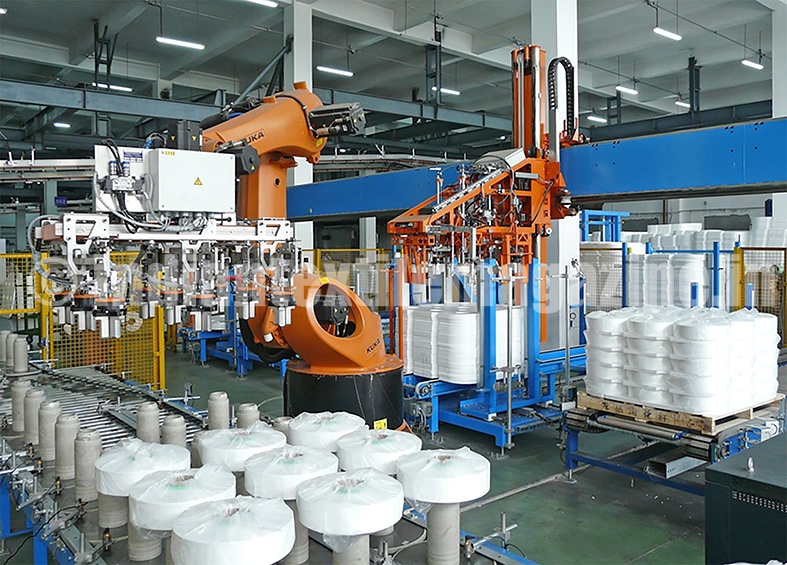With more than 30 years of experience in the field of man-made fiber automation, the German AC-Automation Filament team is prepared to fulfill all customer demands. The focus always is to bring maximum benefit and functionality to the customer. By offering highly sophisticated textile machinery for filament handling, in combination with a state-of-the-art automation system commonly developed out of one hand for perfect interfacing, the customers already start to benefit from this “turn-key” supply at a very early stage.
In recent years the main motivation for investing in “Filament Automation” was the independency from, and reduction of workforce with a consequential quality increase of the final product.
The latest tendency in industrial production and the next step in the development chain is the so-called “Industry 4.0”, which stands for complete cross-linking of information technology of installations, including connection to the outside, e.g., the customer. This new step of industrial production is frequently called “smart factory”.
This term defines the fourth industrial revolution, following the first which included mechanizing of water and steam power. The second revolution specified mass production by application of assembly lines and electric energy, followed by the third revolution which included the use of IT and electronics.
The target is self-monitoring and self-controlling production based on real-time processing of accumulating data and information. This type of cross-linking and information processing is required for the production processes becoming more and more flexible.
Today’s installations realized by AC-Automation of Germany mostly already provide these requirements to be able to take the next step in production technology. AC-Automation is able to visualize the condition of its installations by means of supervisory control and data acquisition (SCADA). The service life of single installation components and spare parts can be recorded by a spare parts management software system for each specific installation, and the corresponding spare parts provision can be effected automatically. Production and order data can be transferred by means of interfaces to the customer ERP system. They may include various packing types (the number of layers per pallet, pallet type, etc.). After completion of each particular packing mode, the pallet data, including each single bobbin data set is transferred to the downstream warehouse management system (WMS). The complete plant set-up and status can even be displayed and indicated on any smartphone for remote control.
The company is also in the process of introducing manufacturing execution systems (MES), computerized systems used in manufacturing. MES track and document the transformation of raw materials through finished goods. MES can provide the right information at the right time and show the manufacturing decision maker “how the current conditions on the plant floor can be optimized to improve output.”
MES work in real time to enable the control of multiple elements of the production process (e.g., inputs, personnel, machines and support services) and enable the company to better monitor the overall equipment effectiveness (OEE) and the total cost of ownership (TCO). The idea of MES might be seen as an intermediate step between, on the one hand, an Enterprise Resource Planning (ERP) system, and a Supervisory Control and Data Acquisition (SCADA) or process control system on the other.
The AC-Automation CEO, Mr. Rolf Gaenz, is personally taking care of further development of MES systems and virtual commissioning within the company.
Within the automation processes various ways of communication may be applied to reach the best possible process automation. Beginning with the doffer interface, which receives upstream production data (including existing quality characteristics) from the winder controls up to automatic laboratory equipment. This automatically transfers test results of single bobbins to the AC-Automation data base.
All components, interfaces and possibilities described herein have already been realized and applied by AC-Automation. From today’s point of view this is already a worthwhile investment in the future production world, always scalable, modularly extensible and suitable for upgrades anytime.

